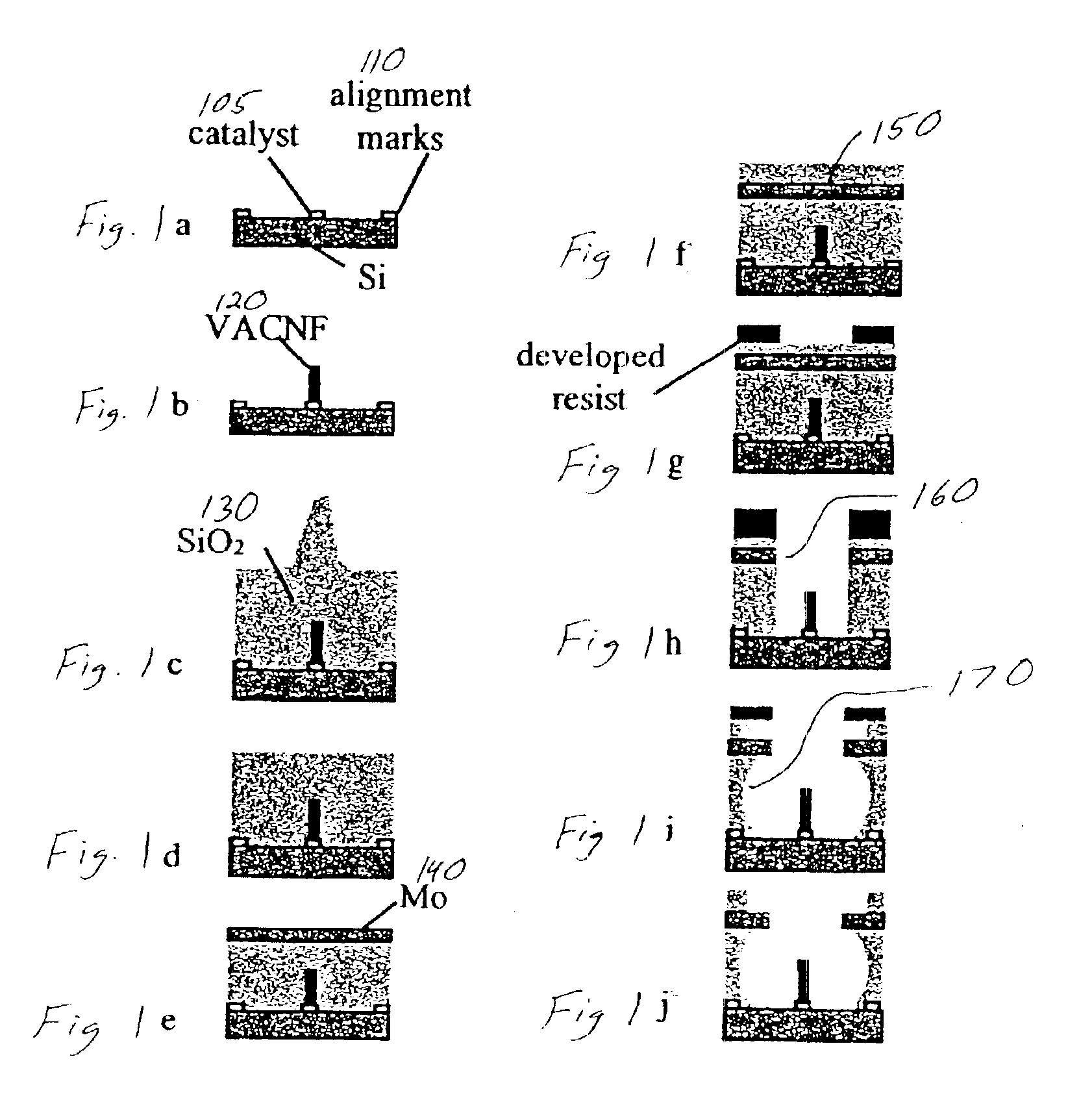Gated fabrication of nanostructure field emission cathode material within a device
a nanostructure and cathode material technology, applied in the field of gated field emission cathode materials within a device, can solve the problems of reducing the work of gated cathode structures using these materials as fe elements, affecting the construction of fe devices, and reducing the work of gated cathode structures
- Summary
- Abstract
- Description
- Claims
- Application Information
AI Technical Summary
Benefits of technology
Problems solved by technology
Method used
Image
Examples
example 1
[0064]FIGS. 1A-1J depict a process flow for fabrication of the gated cathode structures. Three-inch diameter low resistivity n-type Si wafers were used as substrates throughout this example. Prior to performing processing, the substrates were cleaned in a solution of ammonium fluoride and hydrofluoric (HF) acid 6:1 for 60 s to remove native oxide from the substrate surface. Immediately following this cleaning, the substrates were spin coated with a bilayer of polymethyl methacrylate (PMMA, MicroChem, Nano PMMA). The bilayer consisted of two different molecular weight PMMA formulations to produce an undercut in the developed resist sidewall profile to facilitate liftoff pattern transfer. The lower layer was a 4% 495K PMMA in anisole spun onto each substrate at 4000 rpm for one minute to produce a 1000 Å thick layer. Following spin coating, each substrate was baked for 15 minutes on a 170° C. hotplate. After removing the substrates from the hotplate, a layer of 2% 950 k PMMA in methyl...
example 2
[0080]A schematic diagram of a different device fabrication process for the gated cathode structures is shown in FIGS. 7A-7I. Whole 3″ or 4″ low resistivity n-type Si wafers were used as substrates throughout this example. Conventional high-resolution electron beam lithography (EBL) and liftoff pattern transfer was used to define catalyst site(s) 710 for deterministic growth of VACNF and alignment marks for subsequent lithographic patterning processes (see FIG. 7A). The catalyst site pattern consisted of 100-nm diameter circles. These patterns were metallized with 100 Å of Ti followed by 100 Å of Ni deposited by electron beam physical vapor deposition (PVD). The Ti layer was deposited between the Ni catalyst and Si substrate to prevent catalyst silicide formation at the moderately high growth temperature of approximately 700° C. The wafers were mounted directly on a heated cathode inside the PECVD growth system. After evacuating the growth system to a suitable base pressure, the tem...
example 3
[0082]A schematic diagram of a self aligned fabrication process for the gated cathode structures is shown in FIGS. 9A-9F. In this example, whole 3″ low resistivity Si n-type wafers were used as substrates. Electron beam lithography and physical vapor deposition (PVD) were used to realize the catalyst site(s) 910 for VACNF growth and alignment marks for subsequent lithographic patterning (see FIG. 9A). DC plasma enhanced chemical vapor deposition (PECVD) of VACNF material 920 was performed at 700° C. (see FIG. 9B). This process produced VACNF that were 1-μm tall on average with tip diameters of less than 30 nm. A 1.2 μm thick layer of SiO2 930 was deposited onto the substrates using a silane-based rf PECVD process and resulted in the formation of conformal mounds surrounding the VACNF emitters (see FIG. 9C). The gate electrode 940 was defined using photolithography, omitting any lithographic definition of apertures aligned to the VACNF emitters. The gate pattern was metallized with 5...
PUM
| Property | Measurement | Unit |
|---|---|---|
| diameter | aaaaa | aaaaa |
| oblique angle micrographs | aaaaa | aaaaa |
| diameter | aaaaa | aaaaa |
Abstract
Description
Claims
Application Information
 Login to View More
Login to View More - R&D
- Intellectual Property
- Life Sciences
- Materials
- Tech Scout
- Unparalleled Data Quality
- Higher Quality Content
- 60% Fewer Hallucinations
Browse by: Latest US Patents, China's latest patents, Technical Efficacy Thesaurus, Application Domain, Technology Topic, Popular Technical Reports.
© 2025 PatSnap. All rights reserved.Legal|Privacy policy|Modern Slavery Act Transparency Statement|Sitemap|About US| Contact US: help@patsnap.com



